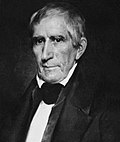Founding
Upon the death of President William Henry Harrison thirty days into his term, Vice President John Tyler took office, and would serve for the remaining 47 months of Harrison's four year term. Despite the fact that Harrison and Tyler were both members of the Whig Party, Tyler found much of the Whig platform unconstitutional, and he vetoed several bills favored by party leader Henry Clay. In 1841 Tyler was forced out of the Whig Party after continued contention with Whig leaders. [1] One year later, the Whig Party was routed in the 1842 House elections, where the party lost sixty-nine seats. By 1844, the Whigs would lose control of the Senate.
After being expelled from the Whig Party, Tyler attempted to return to the Democratic Party, but the still pro-Van Buren party would not allow him to enter. This led to Tyler's realization that the only way he could maintain his legacy was to show public support for a proposed annexation of Texas. [4]
On the same day as the Democratic Convention, thousands of Tyler supporters marched to Baltimore, Maryland, and held their own convention. They believed that the Democrats, deadlocked between Martin Van Buren and Lewis Cass, would choose Tyler as a compromise candidate to unite the party. [5] Democratic editor James Gordon Bennett Sr. of the New York Herald , then among the most popular newspapers in the country, [6] would tacitly lend his support to Tyler's nomination. [2] Tyler would additionally endorse a smaller newspaper, The Madisonian, as his campaign's official organ. However, the Democrats instead chose James K. Polk, a former Speaker of the House, as their candidate, much to the dismay of the Tylerites.

